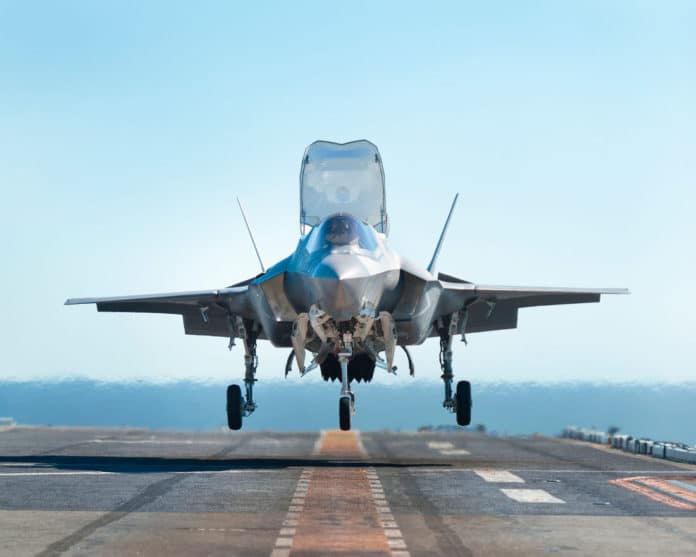Tests of how Lockheed Martin Corp.’s F-35 will perform in combat won’t begin until at least August 2018, a year later than planned, and more than 500 of the fighter jets may be built before the assessment is complete, according to the Pentagon’s test office.
“These aircraft will require a still-to-be-determined list of modifications” to be fully capable, Michael Gilmore, the Defense Department’s top weapons tester, said in his annual report on major programs. “However, these modifications may be unaffordable for the services as they consider the cost of upgrading these early lots of aircraft while the program continues to increase production rates in a fiscally constrained environment.”
The Defense Department plans a fleet of 2,443 F-35s for the United States, plus hundreds more to be purchased by allies, including the United Kingdom, Italy, Australia and Japan. The costliest U.S. weapons program, at a projected $391 billion, the F-35 is being produced even as it’s still being developed, a strategy a top Pentagon official once called “acquisition malpractice.”
Despite the plane’s many problems, “F-35 production rates have been allowed to steadily increase to large rates,” Gilmore said in his annual report to congressional defense committees.
The Pentagon wants to increase the number of F-35s purchased for the U.S. to 92 annually by 2020 from 38 last year. The number jumps to 120 a year when foreign sales are included. For this year, Congress added 11 aircraft to the 57 requested.
Marillyn Hewson, Lockheed’s chairman and chief executive officer, told analysts on a Jan. 26 earnings call that the company expects to increase F-35 deliveries to about 100 in 2018 from 45 last year. The F-35 is built at Lockheed’s Fort Worth plant.
Gilmore said the delay in testing stems from flaws in the “3F” software that gives the F-35 its full combat capability. Testing of the software isn’t likely to be completed until at least January 2018, or 15 months behind the October 2016 date set when the program was reorganized in 2012, he said. The F-35 is a flying computer, with more than 8 million lines of software code.
Joe DellaVedova, spokesman for the Defense Department’s F-35 office, said in an email that the program “continues to aggressively execute development and testing of Block 3F capabilities with the objective of delivering” them about mid- September 2017. He said the program office doesn’t intend to take any shortcuts.
The F-35’s $55 billion development phase is evaluating how well aircraft and systems meet contract specifications and military requirements. Combat testing, which takes at least a year, puts all the pieces together to stress the aircraft in realistic war-fighting scenarios — such as how well a four-jet formation detects and shares data about sophisticated Russian or Chinese air defenses during realistic mock missions.
The Pentagon will need the results of the testing before proceeding with full-rate production, the most lucrative phase for Bethesda, Maryland-based Lockheed, the largest U.S. contractor. Full-rate production is currently scheduled for April 2019.
The next milestone for the F-35 is supposed to be an Air Force declaration by August that its version of the F-35 has initial combat capability. The Marines declared their version’s initial capability in July.
The Air Force last month told a Joint Chiefs of Staff weapons review group it rated that date as jeopardized, or “red,” because of “inherited deficiencies” with its “Block 3i” software and “new avionics stability problems,” Gilmore wrote.
DellaVedova said that the 3i “software has been continually improved.” Deficiencies in air-to-air and air-to-ground mission sets “were addressed and resolved,” he said.
Other F-35 flaws cited by Gilmore in his report:
– A fuel system deficiency on all three models of the plane that limits their maneuverability when carrying a full load of gas.
– A diagnostic system, called “ALIS,” that continues “to demonstrate poor accuracy and a high false alarm rate.”
– Cracks in wing spars discovered in October on the Navy version of the F-35 and “damage to a significant number of fasteners and grommets” found during testing of the Marine Corps model.
– A lack of high-fidelity simulators to rehearse combat missions and specialized data for each major geographic area that pilots will use to test sensors and track enemy radar.
– A pilot escape system that could kill ejecting pilots who weigh 136 pounds or less by breaking their necks. DellaVedova said the program office plans improvements by November to fix the neck-stress issue.
Gilmore’s report also contained signs of progress:
– A new helmet made by Rockwell Collins Inc. has shown improvements in reducing jittery or misaligned images displayed on the pilot’s visor.
– Failures caused by Lockheed-supplied parts have decreased, showing the most improvement of all reliability measures.
– F-35s were available 51 percent of the time required for training and flight tests in 2015, an increase from 37 percent in 2013 and 2014 but still short of a 60 percent goal for the year.






